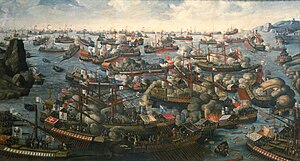Ottoman conquest of Cyprus
| Fourth Ottoman–Venetian War | |||||||||
|---|---|---|---|---|---|---|---|---|---|
| Part of the Ottoman–Venetian Wars | |||||||||
 The Battle of Lepanto |
|||||||||
|
|||||||||
| Belligerents | |||||||||
|
|
|||||||||
| Commanders and leaders | |||||||||
|
|
Selim II Sokollu Mehmed Pasha Piali Pasha Lala Kara Mustafa Pasha Müezzinzade Ali Pasha † Occhiali |
||||||||
The Fourth Ottoman–Venetian War, also known as the War of Cyprus (Italian: Guerra di Cipro) was fought between 1570 and 1573. It was waged between the Ottoman Empire and the Republic of Venice, the latter joined by the Holy League, a coalition of Christian states formed under the auspices of the Pope, which included Spain (with Naples and Sicily), the Republic of Genoa, the Duchy of Savoy, the Knights Hospitaller, the Grand Duchy of Tuscany, and other Italian states.
The war, the pre-eminent episode of Sultan Selim II's reign, began with the Ottoman invasion of the Venetian-held island of Cyprus. The capital Nicosia and several other towns fell quickly to the considerably superior Ottoman army, leaving only Famagusta in Venetian hands. Christian reinforcements were delayed, and Famagusta eventually fell in August 1571 after a siege of 11 months. Two months later, at the Battle of Lepanto, the united Christian fleet destroyed the Ottoman fleet, but was unable to take advantage of this victory. The Ottomans quickly rebuilt their naval forces, and Venice was forced to negotiate a separate peace, ceding Cyprus to the Ottomans and paying a tribute of 300,000 ducats.
The large and wealthy island of Cyprus had been under Venetian rule since 1489. Together with Crete, it was one of the major overseas possessions of the Republic, with a population estimated at 160,000 in the mid-16th century. Aside from its location, which allowed the control of the Levantine trade, the island possessed a profitable production of cotton and sugar. To safeguard their most distant colony, the Venetians paid an annual tribute of 8,000 ducats to the Mamluk Sultans of Egypt, and after their conquest by the Ottomans in 1517, the agreement was renewed with the Ottoman Porte. Nevertheless, the island's strategic location in the Eastern Mediterranean, between the Ottoman heartland of Anatolia and the newly acquired provinces of the Levant and Egypt, made it a tempting target for future Ottoman expansion. In addition, the protection offered by the local Venetian authorities to corsairs who harassed Ottoman shipping, including Muslim pilgrims to Mecca, rankled with the Ottoman leadership.
...
Wikipedia
